Since 2001, Animal People has co-sponsored the Asia for Animals conference. This year, the AfA was held in Kuching, Malaysia from October 6-10 (learn more). During the two weeks beforehand, Animal People executive director Wolf Gordon Clifton traveled in Indonesia visiting different animal welfare-related projects. This series of articles, “Archipelago Animal Adventures,” is intended as a travelogue to document what he saw, for the benefit of activists in Indonesia and across the world striving to improve animal welfare in the archipelago.
Unless otherwise marked, all photos are free to use for non-commercial purposes, as specified under CC BY-NC 4.0.
Previous:
Winds of Change Along the Java Sea: Archipelago Animal Adventures, Days 1-2
Escape From Raptor Island: Archipelago Animal Adventures, Day 3
__
Day Four: Sunday, September 27th
As mentioned in previous entries, Jakarta traffic is extremely heavy, and becomes only barely more manageable as one leaves the city. The only way to avoid it is to travel very late at night or early at morning. And so, getting to the Cikananga Rescue Center, deep in the interior of Java, in less than six hours required leaving the hotel well before 6:00 AM.
The Cikananga Rescue Center exists to shelter and rehabilitate rescued wildlife, and works closely with the Jakarta Animal Aid Network, with which it shares some of its facilities. From what I had heard of the Center previously, I imagined it to be some remote compound hidden deep in the jungle, far from human settlements. Yet for all the hours we drove, never once did civilization fall out of sight. The roadside was densely populated the entire way, without even clear boundaries between towns. Eventually the settlements did thin out some, with more farmland and larger patches of trees between buildings, but nothing that could really be characterized as forest.
- Birds in cages along the side of the road
- Dog in front of a shop
- Soapstone workshop
- Soapstone being carved
- Tea plantation
- Tea plantation
- Forest cleared for crops
I was disturbed at one point to see men with a large pack of dogs on leashes, who my driver Mr. Dana told me were on their way to hunt wild pigs that ate their crops.
- Men and dogs going to hunt pigs
- Men and dogs
- Men and dogs
When we finally arrived at the Cikananga Rescue Center, it turned out to be on the outskirts of a small village. The village was remote in the sense that it was economically underdeveloped, with few residents having TV or internet and none possessing hot water, but in terms of population density it was only a little sparser than most of the areas we had passed through, and blurred at its edges into neighboring settlements with little wild area in-between. The severity of Indonesia’s overpopulation and deforestation crises was obvious to see.
- Village of Cikananga
- Dog
- Dog in yard
- Goats inside a shed
- The bungalo where I spent the night
- My bed
- The view from my balcony
- Farmer working his field, with dog for company
- Farmer and dog
- Dogs in field
Dr. Alia, the veterinarian in residence at Cikananga, gave me a tour of the center. The first stop was a massive aviary, containing a microcosmic jungle populated with deer, blue crowned pigeons, and peacocks.
- Giant aviary
- Aviary
- Crowned pigeon
- Peacock roosting
- Peacock spreading train
- Peacock
- Peacock
- Dr. Alia and peacock
- The male peacock pecking Dr. Alia’s water bottle
- The female peahen is almost as ornate as the male
- Cockatoo in a smaller aviary nearby
- Cockatoo
From their mostly green plumage, and the fact that besides lacking long trains with eyespots, the female peahens looked nearly identical to the males, it was obvious that Indonesian peacocks are a different species from those I had seen before in India (whose males are mostly blue, and females a drab brown). Dr. Alia confirmed this to be the case. I hadn’t realized before that there were multiple peacock species (later I learned that there’s also one native to Africa).
We moved on to the crocodiles, many of which had been kept as pets by people who evidently didn’t anticipate how large and dangerous they would grow. I had read before that crocodilians were supposedly the smartest reptiles, and had personally seen caiman (small alligators) in Costa Rica who would lunge at tourists in hopes of getting fed hot dogs, but knew to stop at just the right distance so as to thrill, but not scare away, their food source. Dr. Alia told me about some formal studies of crocodilian intelligence (which I have yet to look up), which show that they like to play, especially by putting leaves or flowers on their heads, and that their favorite color is pink.
- Two crocodiles in enclosure
- Crocodile
- Crocodile with leaf on head. Before coming to Cikananga, this one was kept as a pet in a bathtub. Her snout became permanently bent when she outgrew her tub.
We passed a couple of siamangs, specialized gibbons known for their froglike throat sacs and sonorous call, and an adorable juvenile leaf monkey.
- Siamang
- Juvenile leaf monkey
- Juvenile leaf monkey
From there we moved on to the kitchen, where volunteers were busy preparing food for the animals.
- Volunteer in kitchen
- Porridge in preparation for the sloth bears… hopefully not too hot or cold, but just right!
- Fruits and vegetables
- Fruits and vegetables
- Chicken meat in cooler
- Cages sometimes used to hold rabbits for live feeding, currently empty
Dr. Alia volunteered that in addition to chicken, mice, and occasional live rabbits, the carnivorous animals also sometimes receive pig meat. This happens when wild pigs get into locals’ homes, leading them to call Dr. Alia to come and shoot the pigs. I asked her if she perceived any conflict between rescuing and rehabilitating certain animals, and killing others to feed them. She answered that predatory animals need to be fed, including with live prey for those that need to relearn hunting skills for once they’re released to the wild. Having grown up on a small farm eating meat from animals raised and killed with high welfare standards, and working as a vet sometimes required to euthanize suffering patients, she didn’t have a problem with death as long as it didn’t involve suffering.
As for the pigs specifically, she explained that the pigs do pose significant danger to humans when they enter houses, and that if she didn’t shoot them the locals would kill them anyway, in far crueler ways than by shooting. She decried the hunting of pigs with dogs, as I had seen on the way to Cikananga, and which was also widespread in her homeland of Hawaii. Not only does it cause intense terror and brutal injuries for the pigs, and pose serious danger to the dogs as well, but in seeking to exterminate whole populations living in the wild it differs substantially from killing individual pigs that enter people’s properties out of self-defense.
I can’t say Dr. Alia’s explanations assuaged my discomfort at killing animals or feeding them live to predators, but neither would I presume to dismiss them. I don’t dispute the need to provide carnivorous animals in one’s care with meat (though I believe humans, as omnivores capable of living healthily without meat, should opt for vegetarianism whenever possible). I absolutely reject those (fringe) schools of animal rights thought that deny predators their right to live naturally; after all, without predators, herbivorous animals couldn’t live either, at least not without suffering regular mass starvations whenever they exhausted their resources. The welfare of prey animals in nature actually requires the existence of predators to keep their numbers in check. And much like Yudisthira toward his dog, I believe that one is morally obligated to prioritize the needs of creatures in their immediate care.
On the other hand, surely there has to be some limit to how far one takes this logic. How much is the life of one predator worth, accounting for their ecological importance and one’s duty to care for them, compared to those of the many prey animals that feed them? Should predators who can never be released into the wild, and so will never serve an ecological purpose greater than themselves, continue to receive priority over prey animals?
As for live feeding, is it more humane for a prey animal to die at a human’s hands, and then be fed to a carnivore, or to be killed by his/her natural predator? And is it more ethical for the human keeper to kill the prey him/herself, attempting to provide as painless a death as possible (mice at Cikananga are killed by having their necks dislocated), or to stand back and let the predator do the dirty work? Should live prey be fed exclusively to predators that will again need to hunt in the wild, or does the mental enrichment it may provide lifelong captives justify the practice for them as well?
I don’t feel comfortable giving easy answers – both due to the complexities involved, and the fact that it isn’t my responsibility to make such decisions on behalf of wild animals – but I welcome readers to consider the above dilemmas for themselves.
We continued on to the monkeys, most rescued either directly from the wildlife trade or from people who had bought them from traffickers. Their stories otherwise varied widely.
- Leaf monkeys
- Leaf monkeys
- Leaf monkey
- Leaf monkey
- Crested macaques
- Crested macaques
- Crested macaque trying to pull up plant
- Two of three poorly socialized crab-eating macaques kept together
- Poorly socialized crab-eating macaque
- Sun bear cub housed nearby
- Sun bear cub
The group of crab-eating macaques above were housed together because all of them had lived with humans from infancy, and didn’t know how to behave like monkeys. Macaques are naturally social animals, but can be rather vicious socially, killing individuals who fail to assimilate into the troop. It is for this reason that all the under-socialized macaques were housed together, so they could learn social skills together and form their own troop with minimal risk of violence.
James was a pig-tailed macaque, and came from an especially bad home, where he had been made to use tobacco, cigarettes, and even hard drugs like heroin. He was clearly a rough personality, making threat displays to intimidate Dr. Alia and I, yet had an odd sense of charisma about him as well. Unfortunately, he never kept still enough for me to snap a photo that really captured his imposing presence.
- James
- James picking plants
- James picking plants
My favorite, however, was Moki, a deformed macaque with a squashed face, barrel chest, and stumpy legs. He had an unusual quality of being so ugly he was actually rather cute, and was apparently very sweet in disposition as well, never showing aggression and leaving as little mess as possible for his keepers to clean up. Dr. Alia and several other volunteers told me they liked to hang out with Moki whenever they needed to calm down. I could definitely understand this.
- Moki
- Moki
- With his stumpy limbs, Moki looked more like a cat than a monkey when he walked
The next animals I was shown were Carnivora, including sun bears, leopards, a tiger (hiding from view), and some very friendly otters.
- Sun bear
- Sun bears
- Sun bear
- Leopard stalking me from her enclosure
- Adorable chirping otters!
- Awwwwww…!!!
I was surprised to learn that one of the bears had actually been rescued from the dinner table, bought from a restaurant owner planning to butcher and cook her!
Housed in the same complex as the bears and leopards were a pair of orangutans. I was initially concerned that the orangutans might be disturbed by the predators nearby, but Dr. Alia assured me they were not. I suppose given the size, strength, and intelligence of great apes, they could easily figure out that their carnivorous neighbors posed little threat. Unfortunately, I was unable to get any good photos, as they kept to the shadows at the back of their enclosure.
A new, improved orangutan facility is currently under construction elsewhere on the property.
Besides the large predatory mammals, Cikananga’s carnivore community also included an assortment of large birds of prey undergoing rehabilitation.
- Bird of prey enclosures
- Bird of prey enclosure
- Hawk-eagle in aviary
- Hawk-eagle
- Hawk-eagle
- Hawk-eagle
The hawk-eagle below was a sad case, his wing having been irreparably broken. Forever unable to fly, and racked with pain every time he tried to, he still clearly longed for the skies, frantically hopping about his enclosure and sometimes attempting to take wing. His face was cut raw from repeatedly crashing into the side of his cage. Dr. Alia opined that he would be better off put out of his misery, but that Indonesia’s wildlife laws made it illegal to kill an endangered animal even as an act of mercy.
- Flightless hawk-eagle
- Flightless hawk-eagle
- Flightless hawk-eagle
It is now widely known that birds evolved from dinosaurs. Less widely known is the continued existence of a creature still more dinosaur than bird. Of all the weird and wonderful creatures at Cikananga, none were more impressive than these, the cassowaries: flightless birds as tall as a human, with bony crests, colorful scaly wattles, vestigial wings hidden beneath primitive hair-like feathers, and Velociraptor-like slashing claws used for killing prey and defending against attackers. I spent a good half hour just watching them as they paced their enclosures, waiting to return to the jungle once suitable habitat could be found, and could have easily spent much longer marveling at their primeval appearance.
- Cassowaries
- Cassowary
- Cassowary
One strange creature remained to be seen, however: the fire face. When one of the volunteers at Cikananga referred to a partner group called the Little Fireface Project, I had no idea what the term referred to. I learned that it’s the local name for the slow loris, so called because of the eerie way its eyes reflect light at night. While superficially an adorable but otherwise rather boring animal, the slow loris actually does a good job living up to its epic name. For one, it is venomous – the only venomous primate, in fact – and uses its poisonous bite to paralyze prey and deter attackers (it isn’t normally fatal to humans). It also isn’t especially slow, as individuals in the wild often cover a range of several kilometers per night hunting for prey.
At sunset, I got to attend the feeding of the lorises, administered by volunteer Nadia and her husband. The omnivorous lorises received a variety of fresh-cut fruits, plus mealworms as a source of protein.
- Nadia and John preparing food
- Nadia preparing food
- Loris waiting expectantly to be fed
- Loris
- Loris
- Loris climbing, slowly
- Loris eating
- Loris eating
- Loris eating
- Loris diving for mealworms in bucket
- Loris
Due to their cuteness, lorises are popular as pets – after being captured from the wild and having their teeth cut out without anesthetic to prevent their venomous bite. Most of Cikananga’s lorises were rescued as part of a single huge raid, overwhelming the center’s facilities and requiring them to be housed together in a dark, overcrowded shed. Everyone acknowledged this was far from an ideal situation, made worse by the fact that the lorises were still required by the government as evidence in prosecuting their traffickers. As such, the lorises had spent far too long in captivity, with no immediate hope of being released. Some had developed neurological conditions from the scarcity of sunlight, which the lorises require for proper health despite sleeping most of the day. Accordingly, Dr. Alia and the Cikananga crew were beginning to move some of the worst cases into better lit outdoor enclosures.
Late that night, following dinner, the volunteers and I went out to see the outdoor lorises. We used only red flashlights, a color the lorises cannot see, so as not to disturb them unduly. As we approached their enclosures, the night lit up with glowing red eyes, like a scene from an old-fashioned monster movie. I was delighted to see firsthand how lorises got the name of Fire Face!
- Cikananga volunteers
- Fire Face!
__
Day Five: Monday, September 28th
My fifth day in Indonesia was mostly a travel day, spent returning from Cikananga to Jakarta, and from there flying to Yogyakarta in central Java, where I would visit the organization Animal Friends Jogja. Before leaving Cikananga, however, I accepted an invitation from volunteer Nadia to see the facilities where mice were bred to feed the center’s carnivores.
I expected to see something bleak and dismal, rows of barren cages overcrowded with mice who, bred solely as a food source for other animals, received little in the way of creature comforts. Fortunately, this isn’t what I found.
For rodents kept in captivity, the mice seemed to live very well, probably much better than most pet mice. For such small creatures, the cages were quite spacious, each containing a large number of mice but not to the point of overcrowding. Every box contained soft bedding, and a range of different structures they could explore, climb, and hide in for stimulation. Their keepers obviously cared to provide the mice a decent life, and their efforts seemed to pay off – as best as I can judge from their behavior, the mice seemed to be happy, actively playing, socializing, and climbing to the tops of their cages to observe us.
- Mouse enclosures. The mice in these two are destined to be eaten by other animals. The other cages are used for breeding.
- Mice in enclosure
- Nadia feeding mice
- Mouse climbing
- Mouse
- Mouse peering through top of cage
- Baby mice
- Baby mice
Did seeing the mice apparently happy put me at total ease as to their eventual fates? No, I still feel that the issue of feeding animals to animals poses a difficult dilemma, which all activists should consider carefully when tending to the needs of natural carnivores. But seeing that the Cikananga Rescue Center at least provided its prey animals with a high quality of life, and (hopefully) relatively humane deaths, made it easier for me to accept they had chosen their course of action responsibly.
Mr. Dana and I left the Center around 9 AM, several hours later than when we had started from Jakarta the day before. Accordingly, the traffic was much thicker, and the journey took nearly twice as long – more than seven hours from Cikananga to the Jakarta airport.
Mr. Dana clearly took an interest in animal issues as well. About halfway through he offered to take me to a vegetarian-friendly restaurant he knew of for lunch. Unfortunately I had to decline this particular offer, settling instead for gas station snacks so as to ensure we got back in time for my flight. However, I did agree to several other animal-related detours.
The first was an open-air roadside shop marked by a large banner advertising roosters. Mr. Dana told me that the owner had won many competitions, and I immediately assumed he’d taken me to a cockfighting ring. Fortunately, the reality was much less distressing by comparison: the owner bred roosters for crowing competitions, in which the bird with the loudest call won his keeper a trophy. The man showed me a large number of roosters in wooden cages, and proudly displayed his most celebrated cocks.
- Roosters in cages
- Big rooster
- Rooster breeder posing with cock
- Rooster breeder posing birds on top of cage
- Breeding cage
- Rooster and hen inside breeding cage
- Cages where hens are kept
- Hens inside cages
- Awards won for cock crowing
While benign in comparison to what I had expected, this rooster crowing operation was still far from a model of animal welfare. The birds were nearly all kept in small cages, with the roosters mostly getting a full cage each but the hens – their mothers and mates – living in much more crowded conditions similar to a battery egg farm. The owner was not gentle in the way he handled his birds, for instance grabbing and pulling a hen by the wing when she tried to run away from him. And, of course, his primary source of income came not from winning crowing competitions, but from selling chickens and roosters, most of whom would undoubtedly be eaten, and some perhaps falling into the hands of actual cockfighters.
Along the way, I spotted this poor crab-eating macaque chained to the top of a parked truck. I had Mr. Dana stop so I could take his photograph. The driver and friends gave me some inquisitive looks, but did not attempt to stop me.
- Macaque atop truck
- Chained macaque
- Chained macaque
- Chained macaque
This monkey’s condition foreshadowed our next major stop, the Jatinegara wildlife black market. I have chosen to cover Jatinegara in a separate entry, together with the Pasty bird market which I saw two days later in Yogyakarta. The animals I saw there suffered the greatest cruelty of any I encountered in my trip. The brutal injustice of what I saw done to them has haunted me ever since, and I feel that if nothing else they deserve an article of their own highlighting their peril, and that of the many millions of wild animals similarly torn from their homes to fuel the Indonesian wildlife trade.
Please see Markets of the Damned: Wildlife For Sale in Indonesia to learn about the plight of wildlife in the Jatinegara and Pasty markets.
Continued in Vegan Punks of Yogyakarta: Archipelago Animal Adventures, Day 6

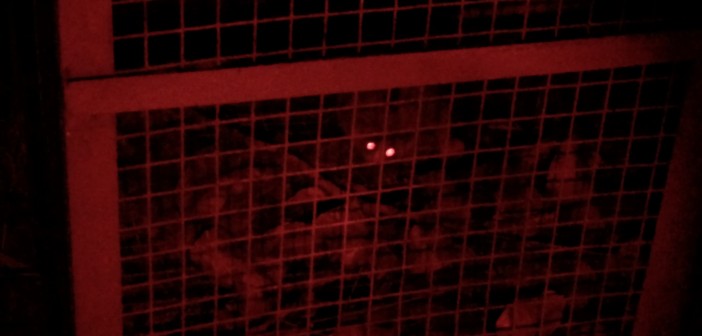
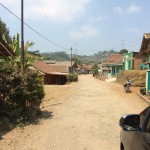
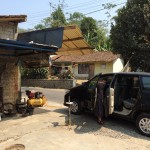
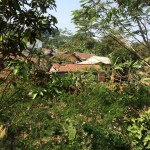
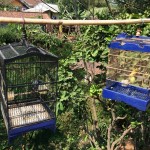
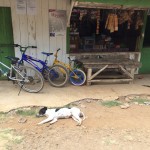
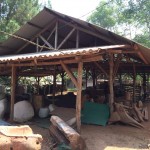

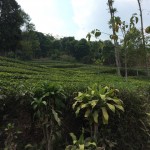
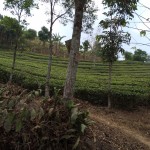
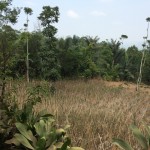

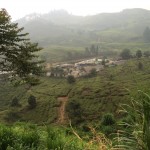
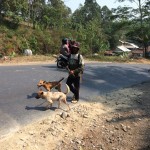
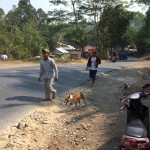

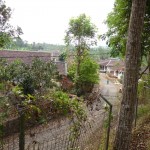
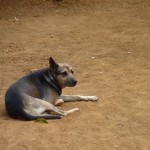

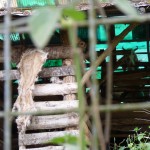
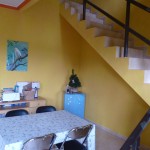

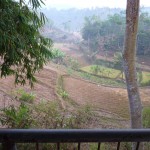
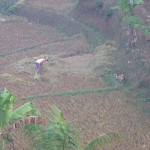
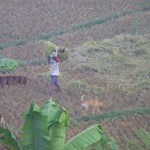
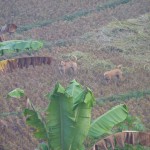
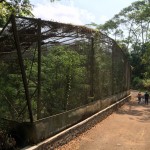
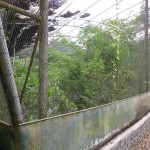


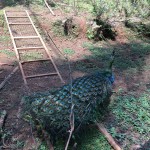

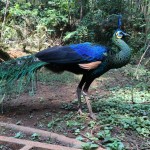


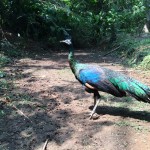
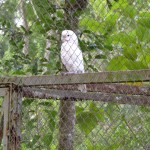




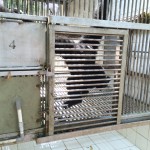
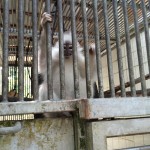
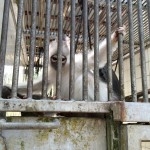
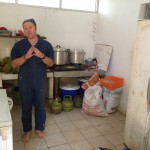
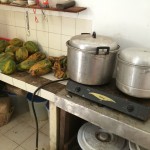
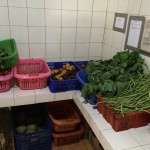
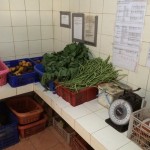

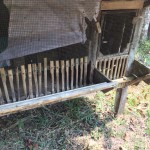
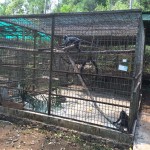
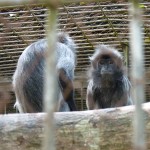
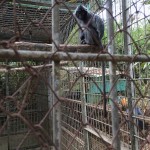
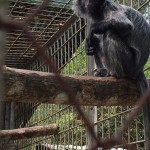
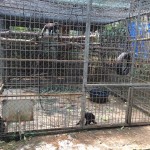

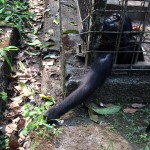
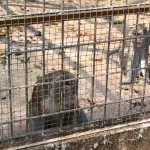
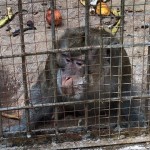


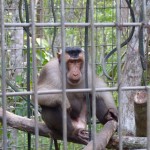
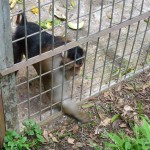
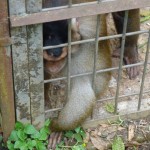
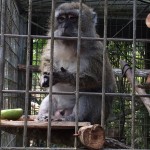
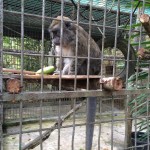
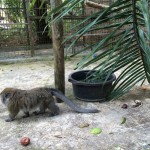
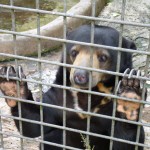

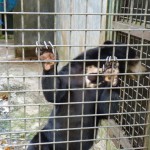

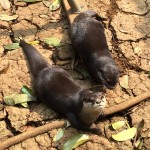


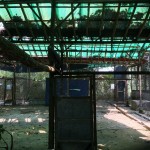
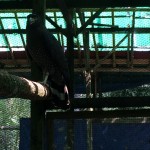




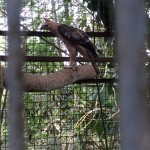
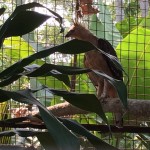

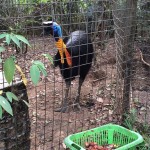

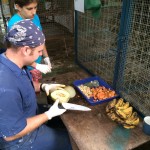
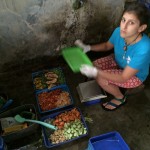
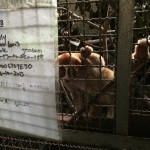
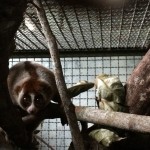



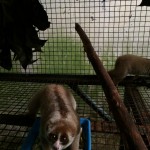
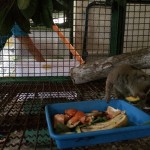

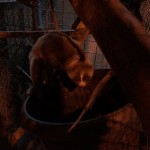
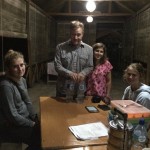
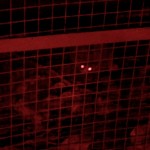
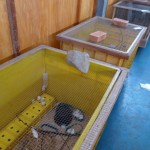
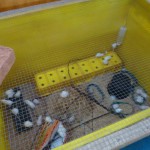

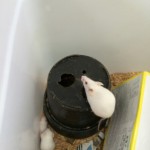
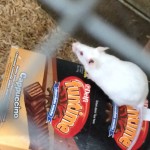
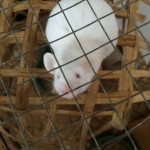

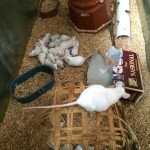
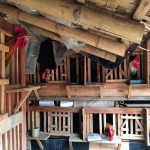

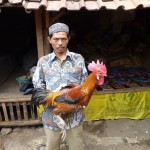

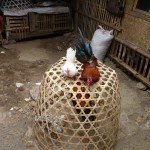




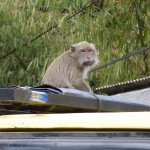
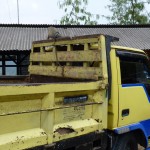
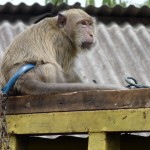
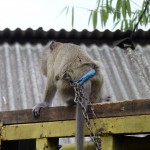




1 Comment
I second your every single bit of perspective , including every single dilemma as posed in the article. Very rich in details. It is an incredible experience to read an article that actually put my thoughts in an organised words.